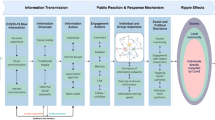Abstract
Evaluating the propagation of ideas on social media platforms such as Twitter allows researchers to gain an understanding of the characteristics of online communication patterns. The expansion and popularity of Twitter has increased the instances of the propagation of rumors and misinformation all over the world. To distinguish the dynamics of the spread of misinformation and legitimate hashtags related to COVID-19, in this paper, we utilized the SEIZ (Susceptible, Exposed, Infected, Skeptic) epidemiological model. We evaluated the trend of the propagation of misinformation and legitimate hashtags from three different campaigns: lockdown, face mask, and vaccine. Our findings showed that the propagation of misinformation and legitimate hashtags can be modeled by the SEIZ model. Leveraging a mathematical model can lead to an increased understanding of the trends of the propagation of misinformation and legitimate information on Twitter and ultimately help to provide methods to prevent the propagation of misinformation while promoting the spread of legitimate information.
Access this chapter
Tax calculation will be finalised at checkout
Purchases are for personal use only
Similar content being viewed by others
Notes
- 1.
- 2.
- 3.
- 4.
References
Van Bavel, J.J., et al.: Using social and behavioural science to support COVID-19 pandemic response. Nat. Hum. Behav. 4(5), 460–471 (2020)
Li, H.O.-Y., Bailey, A., Huynh, D., Chan, J.: YouTube as a source of information on COVID-19: a pandemic of misinformation? BMJ Glob. Heal. 5(5), e002604 (2020)
Pennycook, G., Cannon, T.D., Rand, D.G.: Prior exposure increases perceived accuracy of fake news. J. Exp. Psychol. Gen. 147(12), 1865 (2018)
Tasnim, S., Hossain, M.M., Mazumder, H.: Impact of rumors and misinformation on COVID-19 in social media. J. Prev. Med. Public Heal. 53(3), 171–174 (2020)
Jin, F., Dougherty, E., Saraf, P., Cao, Y., Ramakrishnan, N.: Epidemiological modeling of news and rumors on twitter. In: Proceedings of the 7th Workshop on Social Network Mining and Analysis, pp. 1–9 (2013)
Bettencourt, L.M.A., Cintrón-Arias, A., Kaiser, D.I., Castillo-Chávez, C.: The power of a good idea: quantitative modeling of the spread of ideas from epidemiological models. Phys. A Stat. Mech. Appl. 364, 513–536 (2006)
Xiong, F., Liu, Y., Zhang, Z., Zhu, J., Zhang, Y.: An information diffusion model based on retweeting mechanism for online social media. Phys. Lett. A 376(30–31), 2103–2108 (2012)
Rodrigues, H.S., Fonseca, M.J.: Can information be spread as a virus? Viral marketing as epidemiological model. Math. Methods Appl. Sci. 39(16), 4780–4786 (2016)
Maleki, M., Mead, E., Arani, M., Agarwal, N.: Using an Epidemiological Model to Study the Spread of Misinformation during the Black Lives Matter Movement (2021). arXiv Preprint arXiv:2103.12191
Zhao, L., Wang, J., Chen, Y., Wang, Q., Cheng, J., Cui, H.: SIHR rumor spreading model in social networks. Phys. A Stat. Mech. Appl. 391(7), 2444–2453 (2012)
Isea, R., Lonngren, K.E.: A new variant of the SEIZ model to describe the spreading of a rumor. Int. J. Data Sci. Anal. 3(4), 28–33 (2017)
Rystrøm, J.H.: SEIZ Matters. J. Lang. Work. Studentertidsskrift 5(1), 78–91 (2020)
Gavric, D., Bagdasaryan, A.: A fuzzy model for combating misinformation in social network twitter. J. Phys. Conf. Ser. 1391(1), 12050 (2019)
Holme, P., Rocha, L.E.C.: Impact of misinformation in temporal network epidemiology. Netw. Sci. 7(1), 52–69 (2019)
Acknowledgements
This research is funded in part by the U.S. National Science Foundation (OIA-1946391, OIA-1920920, IIS-1636933, ACI-1429160, and IIS-1110868), U.S. Office of Naval Research (N00014-10-1-0091, N00014-14-1-0489, N00014-15-P-1187, N00014-16-1-2016, N00014-16-1-2412, N00014-17-1-2675, N00014-17-1-2605, N68335-19-C-0359, N00014-19-1-2336, N68335-20-C-0540, N00014-21-1-2121), U.S. Air Force Research Lab, U.S. Army Research Office (W911NF-20-1-0262, W911NF-16-1-0189), U.S. Defense Advanced Research Projects Agency (W31P4Q-17-C-0059), Arkansas Research Alliance, the Jerry L. Maulden/Entergy Endowment at the University of Arkansas at Little Rock, and the Australian Department of Defense Strategic Policy Grants Program (SPGP) (award number: 2020-106-094). Any opinions, findings, and conclusions or recommendations expressed in this material are those of the authors and do not necessarily reflect the views of the funding organizations. The researchers gratefully acknowledge the support.
Author information
Authors and Affiliations
Corresponding author
Editor information
Editors and Affiliations
Rights and permissions
Copyright information
© 2021 Springer Nature Switzerland AG
About this paper
Cite this paper
Maleki, M., Arani, M., Buchholz, E., Mead, E., Agarwal, N. (2021). Applying an Epidemiological Model to Evaluate the Propagation of Misinformation and Legitimate COVID-19-Related Information on Twitter. In: Thomson, R., Hussain, M.N., Dancy, C., Pyke, A. (eds) Social, Cultural, and Behavioral Modeling. SBP-BRiMS 2021. Lecture Notes in Computer Science(), vol 12720. Springer, Cham. https://doi.org/10.1007/978-3-030-80387-2_3
Download citation
DOI: https://doi.org/10.1007/978-3-030-80387-2_3
Published:
Publisher Name: Springer, Cham
Print ISBN: 978-3-030-80386-5
Online ISBN: 978-3-030-80387-2
eBook Packages: Computer ScienceComputer Science (R0)




